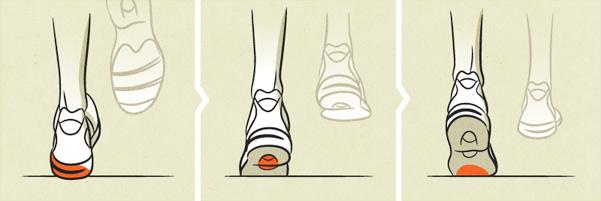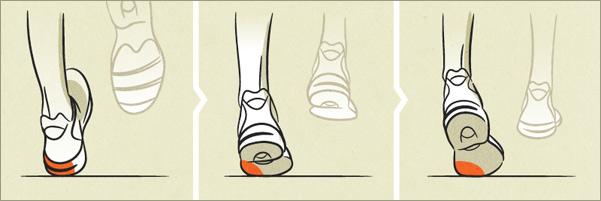Do you know that you might not be using the best running shoes for you? Do you buy your running shoes only because they’re cute and cool? Well, you shouldn’t.
I already knew that when my feet make full contact with the ground, they bent a bit inwards. But while I’m running I notice it even more. And all the tension I get in my lower leg and near Achilles tendon after running might really be because of that.
I’m not an expert in this matter, but I did a little research and I realized that I’m closer to what it’s called an over pronator, even though I don’t have flat feet.
After reading what’s next, can you tell what kind of running style do you have?.
Understanding the pronation pattern (the rolling in of the foot optimally distributes the forces of impact) is very important because it affects the way you run and it may increase the chance of injury. Other than that, matching a shoe’s properties with the runner’s running style will increase comfort and running efficiency.
Here’s some simple and interesting information I gathered from a few websites.
Neutral Pronation:
If the soles of your shoes show wear in an S-shaped pattern, from the outer (lateral) heel to the big toe, you’re a neutral pronator. If you have this running style, you can wear a wide variety of shoes, however, those that offer cushioning and support are most suitable for a neutral pronator.

Pronation pattern of a neutral runner (credits: asics.com)
Over Pronation:
After the outside of the heel makes ground contact, similar to the “normal pronation” sequence, the foot rolls inward excessively. Because of this, the foot and ankle have problems stabilizing the body, and the shock isn’t absorbed as efficiently. This process affects the biomechanical efficiency of the leg, especially the knee and hip. Plus, it causes extra stress and tightness to the muscles and too much motion of the foot can cause calluses, bunions, plantar fasciitis (foot tissues inflammation) and Achilles tendinitis.
So, if you’re an over pronator, you should wear shoes that offer more stability and with firm, multidensity midsoles, with a good arch support, and external control features that reduce pronation and distribute the impact of running more effectively.

Over Pronation (credits: asics.com)
Under Pronation (Supination):
Under Pronation (or supination) is the insufficient inward roll of the foot after landing.
After the outside of the heel makes contact with the ground, there isn’t much or any inward movement of the foot. That results in a large transmission of shock through the lower leg, so, the forces of impact are not distributed as efficiently. Also, most of the work is done by the smaller toes on the outside of the foot. This places extra stress on the foot and can lead to problems with ligaments, stress fractures, Achilles tendinitis and plantar fasciitis. Runners with high arches tend to be supinators.
If you’re a supinator, you should choose lightweight neutral running shoes with plenty of cushioning, to avoid shock-related injuries, common in this kind of pronation, and for some flexibility on the medial (inner) side of the shoe.

Under Pronation or Supination (credits: asics.com)
RUNNING WEEK 6 – 2X 2MIN WALK / 15MIN RUN
New Shoes (Seventeenth Workout)
Duration: 34min
Distance: 4,99km
Average Pace: 6:49min/km
Average Heart Rate: 170 bpm
Distance Record (Eighteenth Workout)
Duration: 34min
Distance: 5,13km
Average Pace: 6:38min/km
Average Heart Rate: 173 bpm
Extra (Nineteenth Workout)
Duration: 15min (only running)
Distance: 2,53km
Average Pace: 5:55min/km
Average Heart Rate: 172 bpm
Bad Mood (Twentieth Workout)
Duration: 34min
Distance: 5,04km
Average Pace: 6:45min/km
Average Heart Rate: 171 bpm
WEEK 7 – 2X 2MIN WALK / 15MIN RUN
Finish strong (Twenty first Workout)
Duration: 34min
Distance: 5,13km
Average Pace: 6:38min/km
Average Heart Rate: 168 bpm
Keep up with the fast lady (Twenty second Workout)
Duration: 34min
Distance: 5,16km
Average Pace: 6:36min/km
Average Heart Rate: 171 bpm
____________________(PT)_____________________
Escolher ténis de corrida
Sabes que podes estar a usar ténis de corrida que não são apropriados para ti? Compras os teus ténis de corrida apenas porque são giros e fixes? Bem, não devias.
Eu já sabia que quando o meu pé apoia totalmente no chão, tende a inclinar um pouco para dentro. Mas enquanto estou a correr noto ainda mais. E toda a tensão que se acumula na minha perna e junto ao tendão de Aquiles após correr pode ter que ver com isso.
Não sou nenhuma expert no assunto, mas fiz uma pequena pesquisa e apercebi-me que me aproximo do que chamam de pronador, mesmo não tendo pé chato.
Depois de leres o que se segue, vais conseguir dizer qual o teu tipo de passada?
Entender o padrão de pronação (a rotação do pé distribui as forças de impacto) é muito importante, pois afecta a forma como corres e pode aumentar o risco de lesão. Para além disso, combinar as características dos ténis com o estilo de passada aumentará o conforto e a eficiência.
Segue-se um apanhado simples e interessante de alguma informação que recolhi de alguns sites.
Passada Neutra:
Se as solas dos teus ténis apresentarem desgaste em forma de S, desde a parte de fora (lateral) do calcanhar até ao dedo grande do pé, tens uma passada neutra. Se tens este tipo de passada, podes usar uma grande variedade de ténis. Aqueles que oferece amortecimento e suporte são os mais aconselháveis.

Passada neutra (créditos: asics.com)
Pronação:
Após a parte de fora do calcanhar tocar no chão, semelhante à passada neutra, o pé pende demasiado para dentro. Devido a isto, o pé e o tornozelo têm dificuldade em estabilizar o corpo, e o impacto não é absorvido de forma eficiente. Este processo afecta a eficiência biomecânica da perna, especialmente no joelho e anca. Para além disso, causa tensões extra nos músculos e movimentos excessivos do pé poderão causar calos, joanetes, fasceíte plantar (inflamação de tecidos no pé), e tendinite no tendão de Aquiles.
Então, se és um pronador, deverás usar ténis que ofereçam maior estabilidade e com palmilhas multidensidade, com um bom suporte para o arco do pé, e características externas que possibilitam a redução da pronação e distribuam o impacto de forma mais eficiente.

Pronação (créditos: asics.com)
Supinação:
A supinação é associada à insuficiente rotação do pé para dentro após o contacto com o chão. Após o contacto da parte exterior do calcanhar com o chão, não existe ou é muito pouca a rotação do pé para dentro. Isto resulta numa grande transmissão de impacto para a perna, não sendo assim distribuído de forma eficiente. Para além disso, a passada é feita essencialmente utilizando os dedos mais pequenos. Tal faz com que sejam criadas tensões extras no pé que poderão levar a problemas de ligamentos, fracturas, tendinite no tendão de Aquiles e fasceíte plantar. Corredores com arco do pé acentuado tendem a ser supinadores.
Se és um supinador, deverás escolher ténis leves de passada neutra, com bastante amortecimento, para evitar lesões associadas ao impacto, comuns neste tipo de passada, e também com alguma flexibilidade na zona média (interna) dos ténis.

Supinação (créditos: asics.com)
SEMANA 6 – 2X 2MIN ANDAR/ 15MIN CORRER
Ténis Novos (Décimo sétimo Treino)
Duração: 34min
Distância: 4,99km
Velocidade média: 6:49min/km
Frequência cardíaca média: 170 bpm
Record de Distância (Décimo oitavo Treino)
Duração: 34min
Distância: 5,13km
Velocidade média: 6:38min/km
Frequência cardíaca média: 173 bpm
Extra (Décimo novo Treino)
Duração: 15min (apenas corrida)
Distância: 2,53km
Velocidade média: 5:55min/km
Frequência cardíaca média: 172 bpm
Mau humor (Vigésimo Treino)
Duração: 34min
Distância: 5,04km
Velocidade média: 6:45min/km
Frequência cardíaca média: 171 bpm
SEMANA 7 – 2X 2MIN ANDAR/ 15MIN CORRER
Terminar forte (Vigésimo primeiro Treino)
Duração: 34min
Distância: 5,13km
Velocidade média: 6:38min/km
Frequência cardíaca média: 168 bpm
Acompanhar a senhora rápida (Vigésimo segundo Treino)
Duração: 34min
Distância: 5,16km
Velocidade média: 6:36min/km
Frequência cardíaca média: 171 bpm

Love this post! Congrats sister!
LikeLiked by 1 person
Thank you!
Qual é o teu tipo de passada?
LikeLiked by 1 person
Julgo ser neutra a tender para supinador…
LikeLike